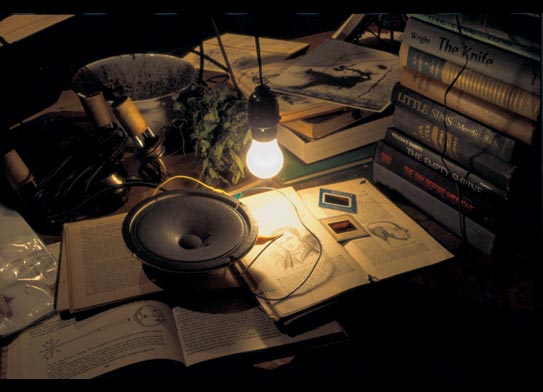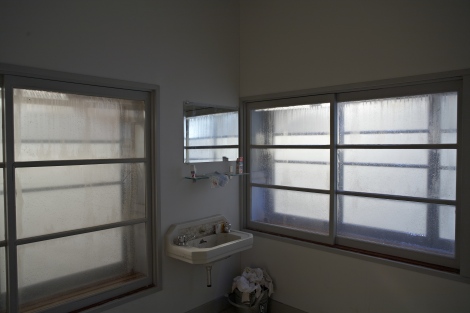[Photo: Zev Tiefenbach]
The world of Canadian artists Janet Cardiff and Geroge Bures Miller exist somewhere between reality and the vortex of our imaginations. . .
The artist duo are known for their of-this-world out-of-this-world creations that combine objects, sound, images, mechanics, lighting, construction, and cinema to create one-of-kind experiments and showcases in the transcendental quality and nature of art.
As one of the world’s most internationally respected artist partnerships, we were lucky to get a chance to enjoy a retrospective of their work, in an exhibit appropriately title “Lost in the Memory Palace”, which runs from April 6 until August 18, 2013 at the Art Gallery of Ontario.
From the beginning of their partnership in 1995 to their work today, the artist duo have expertly managed to create evocative and multi-textural and dimensional works that transport its viewers to other worlds and often exotic states of mind.
The duo has cited cinema as a major driving force in their work, bringing the immersive technology of the cinema to life in a gallery setting, allowing the viewers an accessibility and availability that is mostly foreign to other works in the art gallery setting. While we are often encouraged to keep a distance in the world of art, Cardiff-Miller’s pieces are encouragingly tactile and require a closer look.
This is not a show that you can skim through and really “get” immediately. Going into it with this frame of mind would be disaster.
Like a film, the pieces require a dose of commitment, and an ability to get lost in the world being offered to you by the artists. The worlds are often slightly disturbing as you notice odd-looking effigies, or are startled by an abrupt sound; the element of mystery is definitely in the air, forcing you to question your own reality.
Such is the case with “Dark Pool”, the couple’s first installation created in 1995.
I like that the technology is so popular it is almost invisible so that people can become intimate with it. At the same time the recorded voice is removed and has a sense of past that a real voice doesn’t, so it can actually get closer to the audience through that removal. They feel safe being intimate with a removed voice.
-Janet Cardiff
You are invited to open a paint chipped antiquated door to enter a long, dark, small room filled to the brim with boxes, books, furniture, rolling racks, and antique objects. You might want to, at first, turn back in fear of what could be lurking in the shadows, but very quickly you find yourself exhilarated by curiosity. As you walk through the room, you hear voices and whispers from the past (children, an elderly woman, a young couple), and begin to notice the clues all around you:
[Photos: Cardiff/Miller]
An opened book on reading tea leaves sits behind a tray full of dirty empty tea cups. Two viewfinders, side by side, show a man and woman in a passionate embrace, the other shows a couple with signs of stagnant disdain. You see a collection of porcelain hands. A half-eaten biscuit on a plate. You hear the sound of Judy Garland launch from the radio singing her tragic anthem, “Somewhere Over the Rainbow”. You notice a book that dictates the signs of mental instability.
Often times, as in the case of “Storm Room” (2009), the imagined world is created so thoroughly, you really do question whether the artists have perhaps maneuvered a time slip or some sort of trans-continental teleportation device to get you to the empty Dentist’s office near Tokamachi, Japan, that was recreated for the piece.
[Photo: N.M. Hutcgubson]
An elaborate system of pipes, lighting, and speakers provide an uber realistic rendition of finding yourself unsure, even whilst in the comfort of “safety”. You can hear the coughing of a neighbour in the next “room”, and while you wait for the storm to “end”, you find yourself wondering where exactly you might have landed.
[Photo: N.M. Hutcgubson]
As water streams down the windows, and the rolling sound of thunder rattles the floor, you notice a roll of Japanese dental floss, buckets filling with water, a telephone, some old Japanese calendars, and a floor fan that only helps instil the uncomfortable quality of a 1960s Hiroshi Teshigahara film.
[Photo: Seber Ugarte & Lorena Lopez]
Another unsettling piece, 2007’s “The Killing Machine”, transports to a world unexpected and unknown. Forcing the viewer to imagine the violence and pain of being held on its soft pink fur chair at the will of two elegantly choreographed, rotating stabbing wands, the piece is equally unsettling as it is beautiful.
[Photo: Seber Ugarte & Lorena Lopez]
A statement on the nature of capital punishment, as well as a riff off Franz Kafka’s “In the Penal Colony”, the piece works on the level that it blends these horrors with a beautiful array of coloured lights, a disco ball (who doesn’t love a disco ball?), and almost triumphant orchestration for a bizarrely amusing and eerie imagining of our society’s indifference to killing.
The most impacting piece, had to be the first piece ventured to in the gallery – “Opera for a Small Room” which the couple created in 2005. The piece is a 20 minute long immersion into the tale of a sad and mysterious man (“R DENNEHY”) who speaks throughout the piece about his sad tale of lost love, and a seemingly lost sense of self.
[Photo: Cardiff/Miller]
Contained in a small shed-like space filled to the brim with nearly 2,000 individual records, eight record players, and twenty-four antique loudspeakers; the piece encapsulate a mysterious, melancholy, and mildly sinister mood, all while telling the story of the strange man who embodies the space between the sounds of various arias, sounds, songs, and pop music. The entire story is aligned with the change of synchronized light and colour.
[Photo: Cardiff/Miller]
[Photo: Kunsthaus Bregenz]
Writing is like a 3-Dimensional process for me. The words and sentences have to work with a physical space, resonate with that space. One thing works on the page but it’s a different thing when they are juxtaposed with a physical environment.
–Janet Cardiff
Like a movie in real time playing before your eyes, the works of Janet Cardiff and George Bures Miller are remarkable and exciting works of contemporary Canadian art that we are lucky enough to have gotten the chance to enjoy so closely and thoroughly.
The artists’ cinematic tendencies and unusual combination of various sound and media point to a world where the disparate worlds of various arts and industry can coincide and exist together, for engaging and elevating works of art that not only provide an aesthetic experience, but delve deep into the psyche to penetrate the world of dream, nightmare, and emotion.
To put it plainly, “Lost in the Memory Palace” is as close to Utopia as we’ve seen in this world yet. There are plenty of other pieces by the couple to enjoy at the exhibit, so be sure not to miss out on this incredibly poignant and realized showing on now at the AGO.
“Lost in the Memory Palace: Janet Cardiff and George Bures Miller” at the Art Gallery of Ontario {April 6, 2013 – August 18, 2013}, for more info click here.
Until we meet again,
{theEye}
















Excellent overview. I have a date with the AGO!
LikeLike
Now thats different… I just viewed the Main Street Art Festival and marveled at the varied approaches to Art. But ‘The Memory Palace’ is most unique.
LikeLike
[…] Photo credit: https://theeyeoffaith.com/2013/04/18/the-eye-of-faith-gets-lost-in-the-memory-palace-janet-cardiff-an… […]
LikeLike